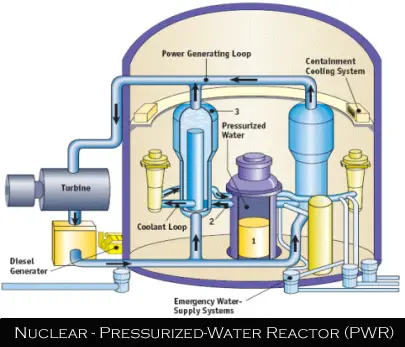Nuclear Pressurized Water Reactors (PWR) are the most common type of reactor, with over 230 in use for power generation and a further several hundred in naval propulsion. PWRs use nuclear-fission to heat water under pressure within the reactor. This water is then circulated through a heat exchanger (called a “steam generator”) where steam is produced to drive an electric generator.
The water used as a coolant in the reactor and the water used to provide steam to the electric turbines exists in separate closed loops that involve no substantial discharges to the environment.

Of the 104 fully licensed reactors in the United States, 69 are PWRs. Westinghouse, Babcock and Wilcox, and Combustion Engineering designed the designed the nuclear steam supply systems (NSSS) for these reactors. After these reactors were built, Westinghouse and Combustion Engineering nuclear assets were combined.
The French-German owned firm Areva NP has acquired many of Babcock and Wilcox’s nuclear technology rights, though portions of the original Babcock and Wilcox firm still exist and possess some nuclear technology rights as well. Other major makers of PWR reactors, including Areva, Mitsubishi, and Russia’s Atomstroyexport, have not yet sold their reactors in the U.S.
